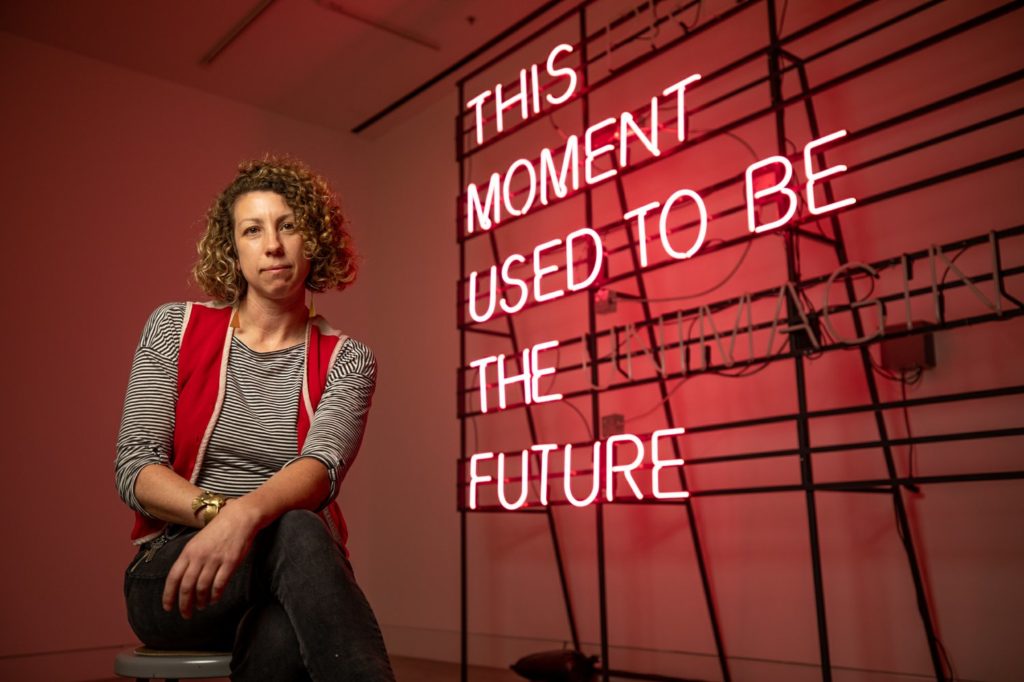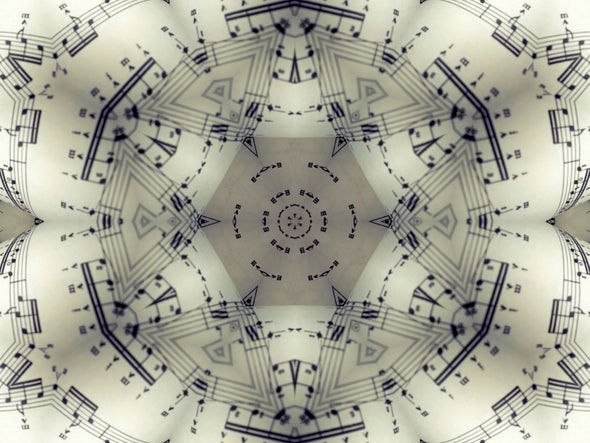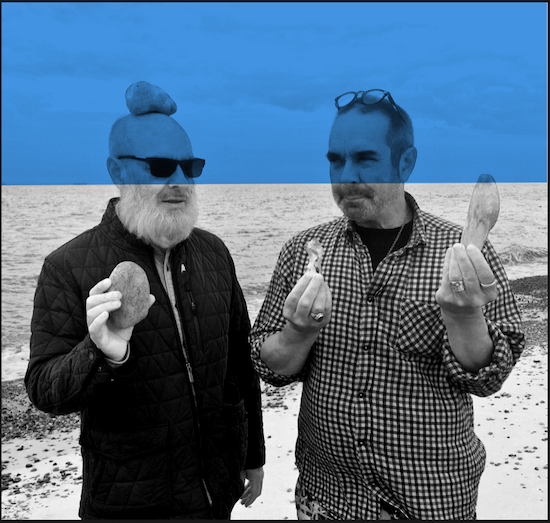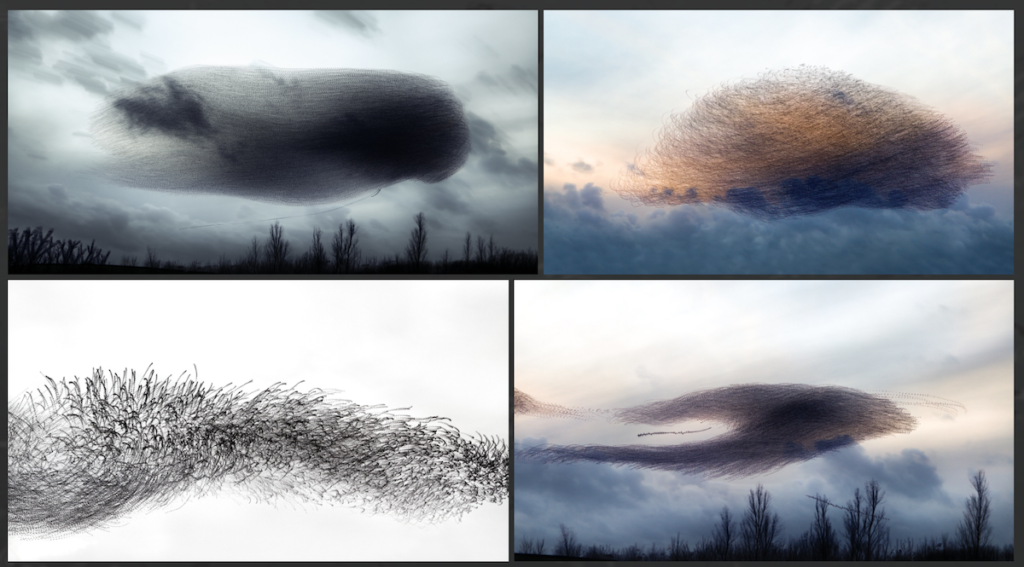
By: The Posts Author | Posted on: 5 Feb 21
Challenging perceptions of time and place to enhance climate change engagement through museumsLong Now co-founder Brian Eno in front of his 77 Million Paintings generative artwork (02007).By Henry McGhie*, Sarah Mander**, Asher Minns***AbstractThis article proposes that applying time-related concepts in museum exhibitions and events can contribute constructively to people’s engagement with climate change. Climate change now and future presents particular challenges as it is perceived to be psychologically distant. The link between this distance and effective climate action is complex and presents an opportunity for museums, as sites where psychological distance can be explored in safe, consequence-free ways. This paper explores how museums
Challenging perceptions of time and place to enhance climate change engagement through museumsLong Now co-founder Brian Eno in front of his 77 Million Paintings generative artwork (02007).By Henry McGhie*, Sarah Mander**, Asher Minns***AbstractThis article proposes that applying time-related concepts in museum exhibitions and events can contribute constructively to people’s engagement with climate change. Climate change now and future presents particular challenges as it

By: The Posts Author | Posted on: 3 Feb 21
Alicia Eggert next to her artwork, This Present Moment (02019-20). Via The University of North Texas. The Smithsonian’s Renwick Gallery has acquired a light sculpture based on quote from Long Now co-founder Stewart Brand’s book on long-term thinking, The Clock of the Long Now (01999). The epigram comes from the book’s final chapter, and has its origins in an exchange between Brand and his friend, the Beat poet Gary Snyder: While I was completing this book, the poet Gary Snyder sent me an epigram that had come to him:This present momentThat lives on to becomeLong ago. I felt it was
Alicia Eggert next to her artwork, This Present Moment (02019-20). Via The University of North Texas. The Smithsonian’s Renwick Gallery has acquired a light sculpture based on quote from Long Now co-founder Stewart Brand’s book on long-term thinking, The Clock of the Long Now (01999). The epigram comes from the book’s final chapter, and has its origins in an exchange

By: The Posts Author | Posted on: 3 Feb 21
Alicia Eggert next to her artwork, This Present Moment (02019-20). Via The University of North Texas. The Smithsonian’s Renwick Gallery has acquired a light sculpture based on quote from Long Now co-founder Stewart Brand’s book on long-term thinking, The Clock of the Long Now (01999). The epigram comes from the book’s final chapter, and has its origins in an exchange between Brand and his friend, the Beat poet Gary Snyder: While I was completing this book, the poet Gary Snyder sent me an epigram that had come to him:This present momentThat lives on to becomeLong ago. I felt it was
Alicia Eggert next to her artwork, This Present Moment (02019-20). Via The University of North Texas. The Smithsonian’s Renwick Gallery has acquired a light sculpture based on quote from Long Now co-founder Stewart Brand’s book on long-term thinking, The Clock of the Long Now (01999). The epigram comes from the book’s final chapter, and has its origins in an exchange

By: The Posts Author | Posted on: 21 Oct 20
Join the Long Now Community for a night of films that inspire long-term thinking. On October 27, 02020, we’ll screen Samsara followed by 2001: A Space Odyssey at Fort Mason. SAMSARA Drive-in Screening on Tuesday October 27, 02020 at 6:00pm PT Get Tickets SAMSARA is a Sanskrit word that means “the ever turning wheel of life” and is the point of departure for the filmmakers as they search for the elusive current of interconnection that runs through our lives. SAMSARA transports us to sacred grounds, disaster zones, industrial sites, global gatherings and natural wonders. By dispensing with dialogue and descriptive text, the film
Join the Long Now Community for a night of films that inspire long-term thinking. On October 27, 02020, we’ll screen Samsara followed by 2001: A Space Odyssey at Fort Mason. SAMSARA Drive-in Screening on Tuesday October 27, 02020 at 6:00pm PT Get Tickets SAMSARA is a Sanskrit word that means “the ever turning wheel of life” and is the point of

By: The Posts Author | Posted on: 16 Sep 20
A new statistical study of 8,000 musical compositions suggests that there really is a difference between music and noise: time-irreversibility. From The Smithsonian: Noise can sound the same played forwards or backward in time, but composed music sounds dramatically different in those two time directions.Compared with systems made of millions of particles, a typical musical composition consisting of thousands of notes is relatively short. Counterintuitively, that brevity makes statistically studying most music much harder, akin to determining the precise trajectory of a massive landslide based solely on the motions of a few tumbling grains of sand. For this study, however,
A new statistical study of 8,000 musical compositions suggests that there really is a difference between music and noise: time-irreversibility. From The Smithsonian: Noise can sound the same played forwards or backward in time, but composed music sounds dramatically different in those two time directions.Compared with systems made of millions of particles, a typical musical composition consisting of thousands of

By: The Posts Author | Posted on: 8 Sep 20
Musicologist Phil Ford, co-host of the Weird Studies podcast, makes an eloquent argument for the preservation of the “Chants to Minimalism” Western Music History survey—the standard academic curriculum for musicology students, akin to the “fish, frogs, lizards, birds” evolutionary spiral taught in bio classes—in an age of exponential change and an increased emphasis on “relevance” over the remembrance of canonical works: Perhaps paradoxically, the rate of cultural change increases in proportional measure to the increase in cultural memory. Writing and its successor media of prosthetic memory enact a contradiction: the easy preservation of cultural memory enables us to break with the
Musicologist Phil Ford, co-host of the Weird Studies podcast, makes an eloquent argument for the preservation of the “Chants to Minimalism” Western Music History survey—the standard academic curriculum for musicology students, akin to the “fish, frogs, lizards, birds” evolutionary spiral taught in bio classes—in an age of exponential change and an increased emphasis on “relevance” over the remembrance of canonical

By: The Posts Author | Posted on: 25 Aug 20
Long Now co-founder Brian Eno on time, music, and contextuality in a recent interview, rhyming on Gregory Bateson’s definition of information as “a difference that makes a difference”: If a Martian came to Earth and you played her a late Beethoven String Quartet and then another written by a first-year music student, it is unlikely that she would a) understand what the point of listening to them was at all, and b) be able to distinguish between them.What this makes clear is that most of the listening experience is constructed in our heads. The ‘beauty’ we hear in a piece
Long Now co-founder Brian Eno on time, music, and contextuality in a recent interview, rhyming on Gregory Bateson’s definition of information as “a difference that makes a difference”: If a Martian came to Earth and you played her a late Beethoven String Quartet and then another written by a first-year music student, it is unlikely that she would a) understand

By: The Posts Author | Posted on: 16 Aug 20
Amazing wildlife photography by Kathryn Cooper reveals the brushwork of birds and their flocks through sky, hidden by the quickness of the human eye. “Staple Newk” by Kathryn Cooper.Ever since Eadweard Muybridge’s pioneering photography of animal locomotion in 01877 and 01878 (including the notorious “horse shot by pistol” frames from an era less concerned with animal experiments), the trend has been to unpack our lived experience of movement into serial, successive frames. The movie camera smears one pace layer out across another, lets the eye scrub over one small moment. “UFO” by Kathryn Cooper.In contrast, time-lapse and long exposure camerawork
Amazing wildlife photography by Kathryn Cooper reveals the brushwork of birds and their flocks through sky, hidden by the quickness of the human eye. “Staple Newk” by Kathryn Cooper.Ever since Eadweard Muybridge’s pioneering photography of animal locomotion in 01877 and 01878 (including the notorious “horse shot by pistol” frames from an era less concerned with animal experiments), the trend has

By: The Posts Author | Posted on: 14 Aug 20
Photograph: Scott Thrift.“We already have timepieces that show us how to be on time. These are timepieces that show us how to be in time.”– Scott Thrift Slow clocks are growing in popularity, perhaps as a tonic for or revolt against the historical trend of ever-faster timekeeping mechanisms. Given that bell tower clocks were originally used to keep monastic observances of the sacred hours, it seems appropriate to restore some human agency in timing and give kairos back some of the territory it lost to the minute and second hands so long ago… Scott Thrift’s three conceptual timepieces measure with
Photograph: Scott Thrift.“We already have timepieces that show us how to be on time. These are timepieces that show us how to be in time.”– Scott Thrift Slow clocks are growing in popularity, perhaps as a tonic for or revolt against the historical trend of ever-faster timekeeping mechanisms. Given that bell tower clocks were originally used to keep monastic observances

By: The Posts Author | Posted on: 17 Jun 20
Paul Cézanne’s ‘Nature morte de pêches et poiresOriginally published at https://www.parallax-magazin.de on June 11, 2020.Now is the time to re-invent the world, to make it beautiful. We need to actually become beautiful, John Vervaeke tells us. Vervaeke isn’t speaking of aesthetic or cosmetic beauty particularly, but something more intrinsic—related to virtue and wisdom. Vervaeke uses the latin term reinventio, which means to create but also to discover the beauty of the world.Becoming beautiful doesn’t mean becoming what Hegel sarcastically called: the beautiful soul—or the one who is overly precious, sanctimonious and refined. No, beauty also has her rough edges and provocations.We often think
Paul Cézanne’s ‘Nature morte de pêches et poiresOriginally published at https://www.parallax-magazin.de on June 11, 2020.Now is the time to re-invent the world, to make it beautiful. We need to actually become beautiful, John Vervaeke tells us. Vervaeke isn’t speaking of aesthetic or cosmetic beauty particularly, but something more intrinsic—related to virtue and wisdom. Vervaeke uses the latin term reinventio, which means to







